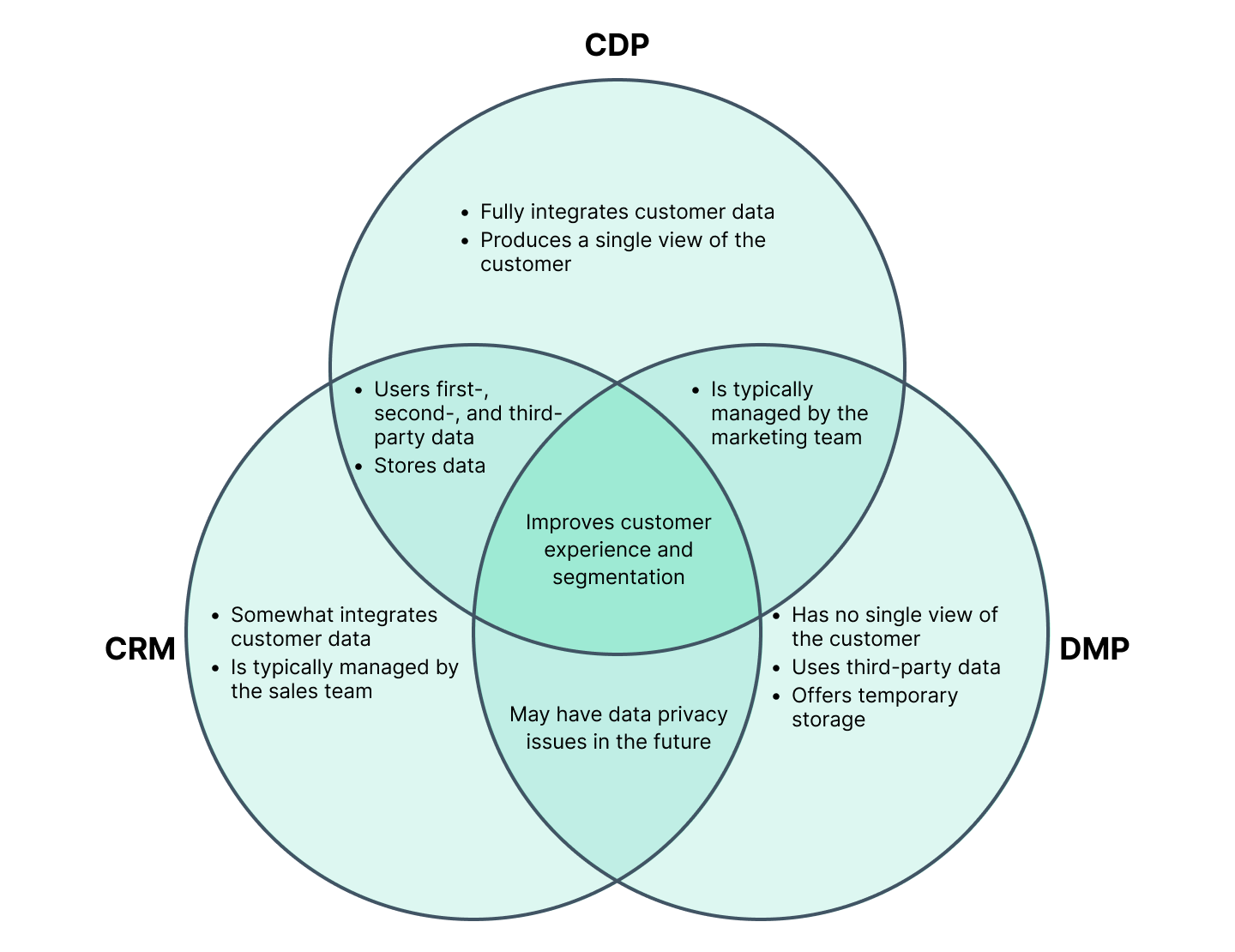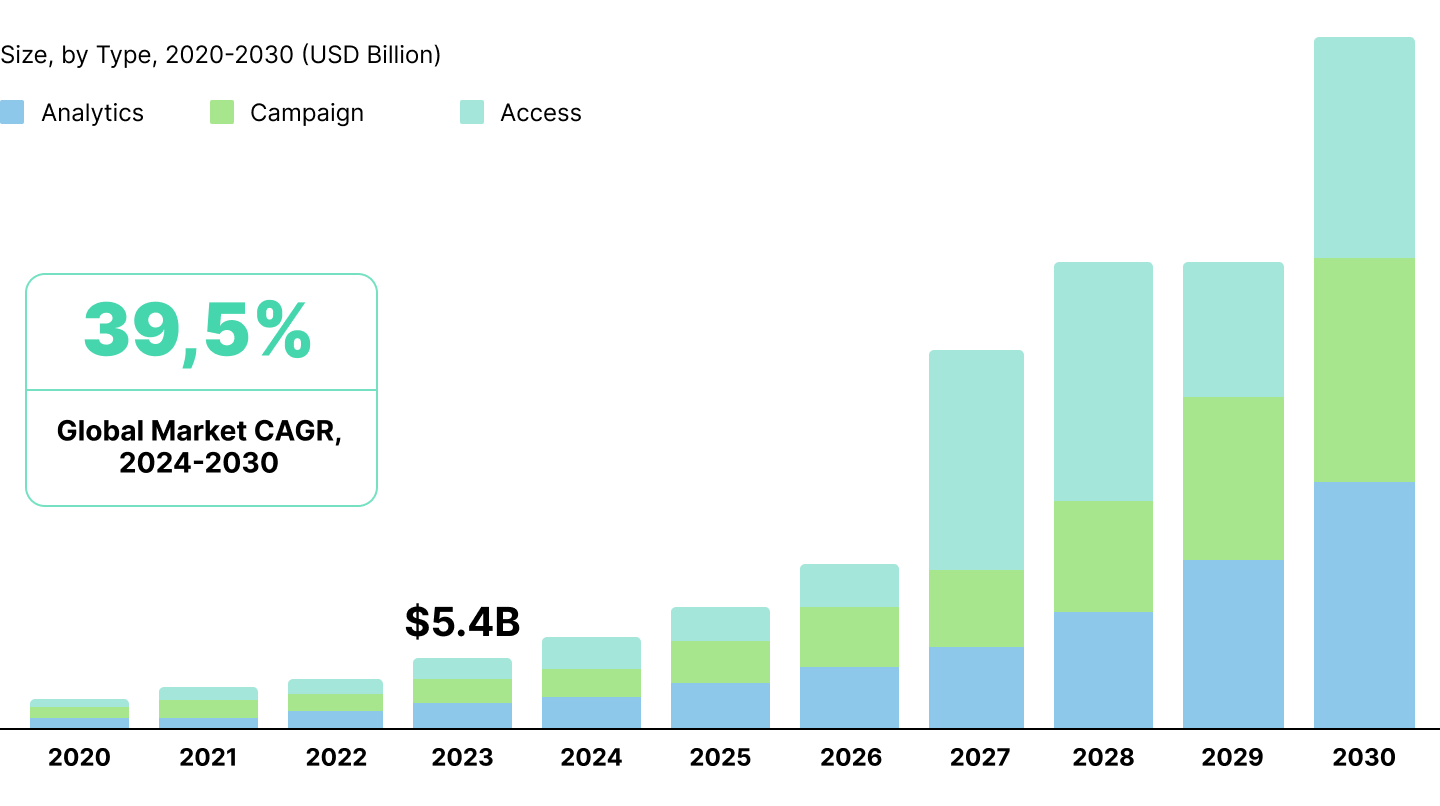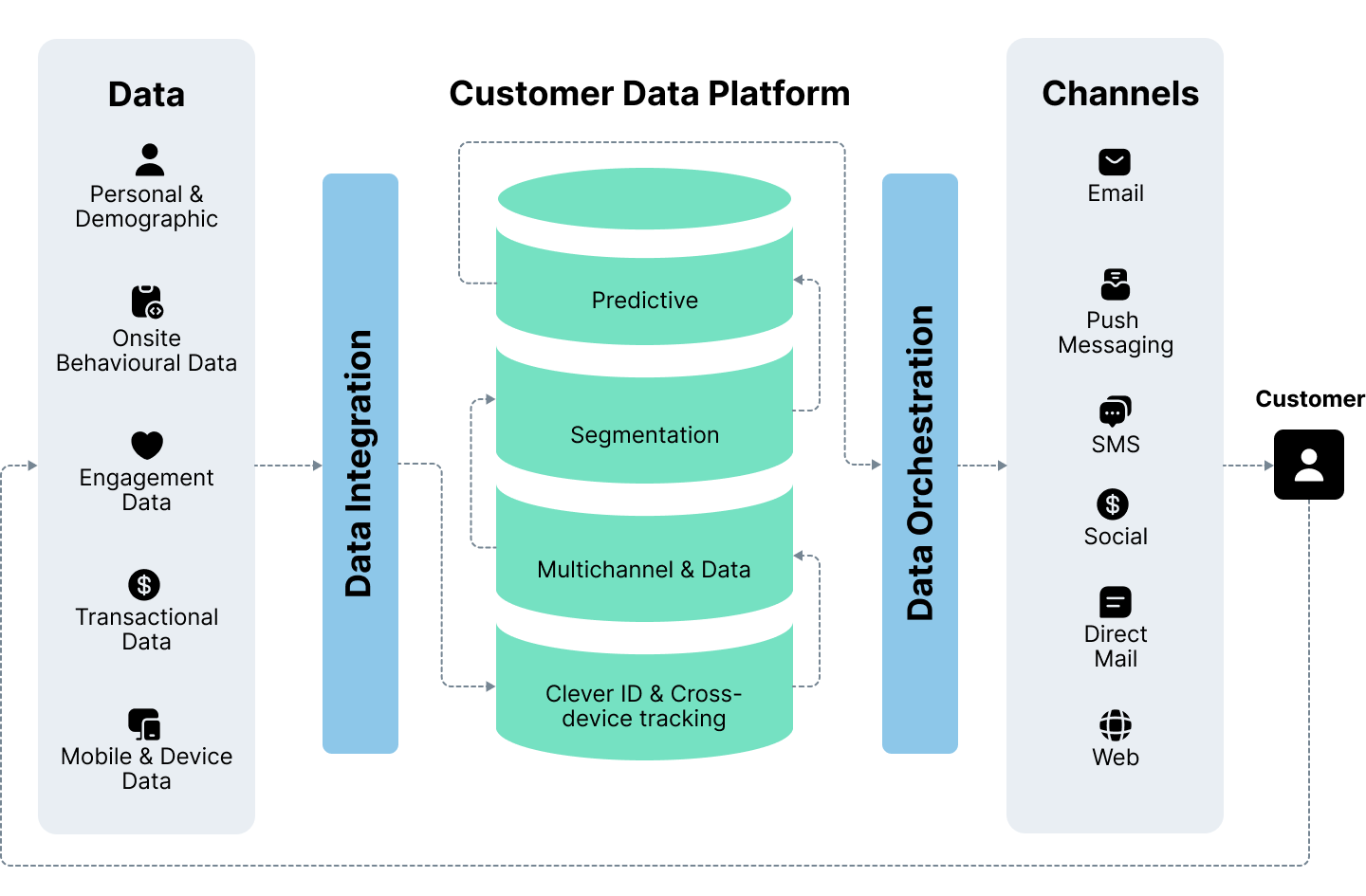This data has the power to transform business operations, providing a granular understanding of customer needs and behavior. But to unlock the power of this data, you need the right platform. This is where a customer data platform for retailers comes in.
A CDP for retail is a transformative tool that consolidates customer data from a range of digital and physical sources. This data is then used to deliver personalized customer experiences, smarter marketing campaigns, and sustainable business growth.
In this article, we’ll explain everything you need to know about CDPs for retail, including:
- What a retail CDP is — and how it differs from other data-driven platforms
- Key CDP features and capabilities to look out for
- How to choose and implement a CDP
- How Intellias can help you at every step of your CDP journey
What is a CDP?
A CDP is a centralized software platform that collects and unifies customer data from multiple sources to gain a single, actionable view of each customer. It then shares this data with other systems and applications, enabling smarter, more data-driven retail operations.
CDPs are often confused with other systems that leverage customer data, like customer relationship management (CRM) platforms, data management platforms (DMPs), and marketing clouds. But there are some key differences to understand:
- CRMs focus on sales and customer relationships, but they lack real-time data unification
- DMPs manage anonymous data for advertising, not persistent customer profiles
- Marketing clouds offer broad marketing suites, but they are less flexible than CDPs for retail-specific use cases

In a modern retail tech stack, a CDP acts as a mobile data layer, seamlessly connecting disparate systems. The result is a cohesive data ecosystem that enables retailers to respond to customer needs quickly and effectively.
As leveraging customer data to deliver personalized services becomes a strategic imperative for retailers, CDPs adoption is steadily growing. In the coming years, the CDP market is forecast to boom, growing at a CAGR of almost 40% through 2030.

Source: Grand View Research
Why does my retail business need a CDP?
CDPs for retail unlock powerful benefits, enabling businesses to gain a coherent understanding of their customers’ needs, preferences, and behaviour. Below, we’ll explore some of the advantages of using a CDP.
Unifying data
Customer data is the lifeblood of your retail business. But if that data is fragmented across multiple touchpoints and systems, it’s harder to leverage it, which hinders your ability to drive growth and customer loyalty. Implementing a customer data platform retail solution can help here.
CDPs combine data from a range of sources, including:
- Point-of-Sale (POS) systems
- E-commerce platforms
- CRMs
- Marketing automation tools
- Analytics platforms
- Customer shopping and delivery apps
- Loyalty programs
This data is then consolidated and unified, providing a 360-degree view of retail shoppers. This opens the door for powerful use cases such as personalized omnichannel experiences and optimized marketing campaigns.
Personalization at scale
With a third of consumers now shopping online at least once a week, your retail business must attract customers in a busy digital landscape to remain competitive. CDPs can help here by facilitating hyper-personalized digital experiences, powered by customer data and AI.
For example, customers can receive personalized recommendations, offers, and marketing communications based on their purchase history, demographics, and shopping behavior. Because these interactions are automated, you can implement personalization across channels — including email, in-app, web, SMS, and even in-store — and at scale.
With 71% of customers now expecting personalized interactions, and 76% getting frustrated when they don’t receive them, CDPs help meet customers’ fast-evolving expectations.
Enhanced decision-making
By providing a unified data layer, CDPs connect with other key systems to deliver actionable insights that drive smarter decision-making across marketing, sales, and customer service. Let’s look at some examples of CDP-powered enhanced decision-making:
- Marketing. Enabling hyper-targeted customer segmentation, powering real-time personalization, and optimizing campaign performance.
- Sales. Providing contextual data, supporting dynamic pricing, and identifying high-value opportunities.
- Customer support. Centralizing customer profiles, providing personalized support experiences, resolving issues proactively.
Increased customer loyalty
Personalized experiences and tailored marketing lead to increased customer satisfaction. The happier customers are, the more likely they are to stick around. Using a CDP can help provide slick interactions designed to nurture long-term relationships, including:
- Personalized rewards and incentives
- Omnichannel loyalty schemes
- Proactive engagement for customers at risk of churn
Enhance regulatory compliance
With growing concerns around retail data privacy, retailers face increasing pressure to comply with stringent regulations like the GDPR. A CDP can play a critical role for your business in ensuring compliance by:
- Centralizing data governance
- Providing detailed audit trails and data logs
- Streamlining consent management
- Implementing data encryption and robust access controls
CDP technology in retail: Core capabilities
CDPs combine a robust set of features to meet the unique needs of modern retailers. If you’re in the market for a CDP, here are some core capabilities to be aware of:
Real-time data ingestion and unification
CDPs collect and unify data from diverse sources in real time. In addition to the software platforms we’ve already mentioned, CDPs can gather data from in-store IoT devices and third-party sources to ensure a complete profile of customer behavior.
CDPs collect data through a combination of direct integrations, APIs, webhooks, and software development kits (SDKs). This can either be done in real time or scheduled batches for systems with less frequent updates.
Identity resolution and customer profiles
CDPs don’t just gather data from multiple sources. They merge fragmented data points into unified customer profiles — known as identity resolution. This provides your business with a complete view of each shopper’s journey, ensuring that you have an accurate and holistic view of each individual.
Identity resolution is achieved through a combination of technologies. Deterministic matching, for example, links data using certain identifiers, such as an email address. More advanced systems use AI and machine learning (ML) to improve matching accuracy.
Segmentation and audience building
A CDP enables you to group customers into meaningful cohorts based on shared characteristics, behaviors, or preferences. This enables a range of customer data platform retail use cases, such as hyper-targeted marketing personalized experiences.
Customer segments can be static, based on stable attributes such as “customers in New York”. Alternatively, they can be dynamic, updating in real time based on changing behaviors, such as “customers who abandoned their cart in the last 24 hours”. Using predictive analytics, customers can even be grouped based on what actions they are likely to take in the future.
Orchestration and personalization engines
Orchestration and personalization are key CDP retail capabilities that turn unified data into real-time experiences. The orchestration part involves coordinating and automating customer interactions across multiple channels. These interactions are triggered by certain events, such as adding an item to a cart, visiting a store, or engaging with a social ad.
Personalization engines ensure that these interactions are tailored to the individual, based on their preferences, behaviors, and predicted intent.
Integrations
A CDP should integrate seamlessly with your existing tech stack, including marketing tools, commerce systems, analytics platforms, and more.
By acting as a central hub and mobile data layer, a CDP unifies customer data from disparate sources and pushes actionable insights to integrated systems. This creates a cohesive tech ecosystem that drives personalized omnichannel experiences, operational efficiency, and growth for your business.

Source: CI&T
AI and predictive analytics
We’ve discussed how AI and predictive analytics enable CDPs to harness customer data, but let’s explore this in greater detail. Integrating AI and ML into a CDP unleashes powerful capabilities, including:
- Hyper-personalized interactions and content generation
- Real-time decision-making
- Identifying and engaging customers at risk of churn
- Enabling dynamic pricing and promotions
- Automated inventory management
And this is just scratching the surface. In short, AI and predictive analytics enable your business to enhance the customer experience, uncover actionable insights, and drive operational efficiency.
How a CDP empowers retailers: key use cases
Now we’ve covered the basics of CDPs, let’s explore how you might use this transformative tech in practice. Below, we’ll list some of the most important customer data platform retail use cases:
- Omnichannel personalization. CDPs use consolidated customer data to deliver consistent, personalized experiences across multiple channels, including web, email, SMS, and in-store. Personalization is a key driver of customer satisfaction and loyalty.
- Product recommendations. CDPs leverage customers’ purchase histories and behavioral data to deliver tailored product recommendations. This strategy increases conversion rates, provides opportunities for cross-selling and upselling, and ultimately drives revenue.
- Retargeting campaigns. CDPs improve the accuracy and effectiveness of marketing campaigns by delivering tailored ads that target specific cohorts, such as high-intent shoppers or people who interact with online content.
- Dynamic pricing and promotions. CDPs leverage AI models, customer data, and market trends to adjust pricing or promotions in real time. Optimizing pricing this way leads to increased conversions and higher revenue, while enabling your business to push certain products strategically.
- Churn prediction. CDPs use AI and ML models to identify customers at risk of churn. They then target those customers with personalized messaging and re-engagement campaigns designed to restore interest and nurture trust.
- Loyalty program optimization. CDPs enable your business to enhance your loyalty strategy, moving away from one-size-fits-all programs and embracing personalized ones that drive engagement and sales.
CDP and retail media networks
Another interesting use case for CDPs is optimizing third-party advertising across retail media networks. CDPs provide the deep customer insights needed to power targeted, third-party advertising across digital channels and physical stores. This is a growing opportunity for retailers to monetize their first-party retail data while showing highly relevant ads to customers.
How CDPs power retail media
A CDP is integral to retail media networks because it provides the unified, actionable customer data needed to power targeted advertising. Here’s how a CDP retail solution supports these networks:
- Rich audience insights. CDPs provide detailed customer profiles and segments for hyper-targeted ad campaigns.
- Real-time activation. CDPs leverage behavioral data to deliver tailored ads at the right moment across both digital and in-store channels.
- AI and predictive analytics. CDPs can use AI to predict customer behavior, enabling brands to target high-intent audiences and maximize ROI.
Choosing the right CDP for your retail business
With the market for CDPs growing, there are an increasing number of CDP vendors to choose from. While most offer similar capabilities, no two platforms are the same. The perfect one for your business will depend on factors such as your budget and goals.
When making a shortlist, we recommend prioritizing platforms that:
- Supports real-time data ingestion, processing, and activation for dynamic insights and omnichannel campaigns
- Can easily handle growing data volumes and complex use cases, enabling it to scale with your business
- Provides seamless, hassle-free integration with your existing retail technology, including marketing, analytics, sales, and customer support platforms
- Leverages AI and predictive analytics for hyper-personalized interactions and automated processes
- Has a user-friendly interface, enabling marketing, analytics, and other teams to manage data and campaigns without deep technical expertise
The size of your business is also a key factor to consider when choosing a CDP. Small and mid-sized businesses will generally want to prioritize ease of use, cost-effectiveness, and quick implementation. Large enterprises, on the other hand, may want to focus more on scalability, advanced analytics, and robust integrations.
Key questions for CDP vendors
Once you’ve created a shortlist of potential CDPs that align with your budget and requirements, it’s time to dig deep into their capabilities. In addition to taking advantage of free trials and demos, we recommend reaching out to CDP vendors with key questions, such as:
- How does your CDP handle real-time data ingestion?
- What integrations are supported out of the box?
- How does your platform ensure data privacy and compliance?
- What AI and predictive analytics capabilities does your CDP offer?
- How does your CDP support audience segmentation and orchestration?
- What is the implementation timeline and process for deploying your CDP?
- How does your CDP scale with growing data volumes and complex use cases?
- What support and training do you provide for ongoing CDP usage?
Evaluating total cost of ownership (TCO)
At this point, you might be wondering how much a CDP costs. When calculating costs, licensing fees alone are just part of the picture. You also need to factor in costs associated with implementation, training, maintenance, and more.
To gain a clear understanding of the TCO of CDP retail solutions, you’ll need to consider the following costs:
- Licensing fees. Monthly or annual subscription costs, which may vary based on features, data volume, and the number of users.
- Implementation costs. Expenses for setup, integration, and data migration, which can be significant for custom or legacy systems.
- Maintenance and support. Ongoing costs for updates, technical support, and training to ensure the CDP remains effective.
- Scalability costs. Additional fees for expanding data storage or processing capacity as your retail business grows.
- Hidden costs. Factor in staff training, data governance efforts, and potential downtime during the implementation phase.
To gain a clearer understanding of how these costs add up, you can request detailed TCO breakdowns from CDP vendors and compare them against expected benefits, such as increased revenue from personalized campaigns or retail media networks.
Best practice for CDP implementation in retail
Choosing the right CDP is only part of the story. CDP success involves effective change management, cross-departmental collaboration, and a strategic approach to implementation. Following the best practices below will help you maximize ROI while mitigating potential issues.
Align stakeholders
Successful implementation and adoption of a CDP requires buy-in from stakeholders from across your organization. To ensure a smooth transition to your new CDP, we recommend identifying key stakeholders from departments like IT, marketing, sales, analytics, and customer service.
You can then define KPIs, making sure they are tied back to wider business objectives, and outline each department’s role in achieving CDP success. Periodically, hold meetings and workshops to align key stakeholders and address CDP pain points, such as siloed retail data or inconsistent customer experiences.
Focus on data hygiene and governance
CDP use cases like personalization and predictive analytics rely on high-quality data. Before migrating data to your CDP, ensure that it is accurate, free of duplicates, and in standardized formats.
To support data cleansing, standardization, and compliance, we also recommend establishing clear data governance policies. This can include:
- Defining rules for data collections, storage, and usage to comply with regulations
- Implementing role-based access controls to mitigate security risks
- Maintaining audit trails to support compliance efforts
Start Small before scaling
To minimize risks and ensure success, we recommend implementing your new CDP incrementally through pilot programs and phased rollouts.
For pilot programs, you can start with a single, high-impact use case, such as personalizing email campaigns for a specific customer segment. Alternatively, you could launch the CDP to a small group of customers or a single region. This allows you to validate the CDP’s effectiveness and identify issues.
After a successful pilot, you can roll out the CDP incrementally across additional channels, regions, or use cases. This allows you to minimize risk and manage change more effectively, ultimately leading to a better customer experience and improved ROI.
Invest in training and change management
Adopting any new software requires effective training and change management, and a CDP is no different. Implementing a CDP will change how your teams manage customer data, collaborate across departments, and deliver personalized omnichannel experiences. The more you can prepare them for this new approach, the more effective it will be. You can ensure a smooth transition to your CDP by:
- Providing role-specific training for marketing, IT, analytics, and other teams
- Making use of your vendor’s educational materials, help articles, and support
- Providing ongoing training as new features or use cases are added
- Communicating the benefits of CDP adoption and addressing resistance proactively
- Celebrating wins from pilot programs to build momentum and confidence
How Intellias can help you implement and deploy a CDP
While implementing a CDP brings powerful benefits, it also represents a major technical and organizational challenge. For a CDP to work effectively, you need to ensure effective data management and seamless integration with existing systems. This is where Intellias can help.
With deep industry knowledge and technical expertise, we help some of the world’s leading retailers harness the power of customer data and transform their businesses through digital innovation. If you’re looking to add a CDP to your retail stack, we can help at every stage of the journey — from defining your broader data strategy and goals to choosing and implementing the right CDP platform.
CDP implementation is just one of the ways we can help take your retail business to the next level. To give you a taste of the work we do, check out some of our retail case studies below:
- All-in-One Retail Service Platform to Enhance the Customer Experience
- Digital Retail Consulting to Orchestrate Data Flows and Operations
- Big Data for Retailers: A Platform for Equipment Monitoring in Supply Chains
Interested in working with us? Get in touch today for a free consultation.



